
Original Link: https://www.anandtech.com/show/1788
AnandTech Exclusive: Sun's sub-$1000 SunFire X2100 Server
by Kristopher Kubicki on September 12, 2005 1:29 AM EST- Posted in
- Systems
Introduction
An interesting policy inside Sun is that you retain your badge number for life. Andy Bechtolsheim retained badge ID #1 at Sun, even after he went on to found Granite Systems and Magma Design Automation. Andy's golden touch extended out to several small companies including a promising little search engine called "Google" as well as academia with Andy's investments into Carnegie-Mellon Universities WCC campus. What does this have to do with Sun's new servers? Well, Andy has some pretty big plans for Sun these days.

Today is the first x64 server for Sun that is totally unlike anything else on the market. While today is also the mark of Sun's Galaxy server line, the SunFire X2100 model (code named "Aquarius") that we are looking at today will become Sun's entry level sub-$1000 server. Vertical markets will be able to use the Aquarius as a completely storage-less application node, while horizontal markets will be able to use the X2100 as a low cost, high density application or web server. We have some upcoming analyses of the Galaxy lineup, but today, we are very excited to bring the first look at Sun's entry level "Aquarius", or SunFire X2100.
Sun's entrance into the sub-$1000 market isn't an easy one. At the sub-$1000 level, whitebox units generally are the brand of choice for most small and medium businesses, while HPC orders get to go to the IBMs and Dells of the world based on volume. With the SunFire X2100, Sun becomes a viable alternative in both the horizontal and vertical markets. By default, the X2100 is configured best for a diskless cluster or high availability application. Once the SunFire X2100 becomes available en masse in the US, we could actually pre-configure the machine for storage and a faster processor instead, making it a very capable web server instead.
Similar to Sun's approach to the V20z and V40z, there will be several different configurations of the X2100, from Small to Extra Large. We actually have an Extra-Large configuration for testing today, which comes out to $2295. Sun tells us the Small configuration comes out to $745; although it doesn't have a hard drive or the beefiest of Opterons, $745 is a bargain for what most companies spend on blades. The Large configuration is priced at $1676. Barring any availability problems from AMD, we should see several versions of the SunFire X2100 in the future with Opteron 154 and 180 processors.
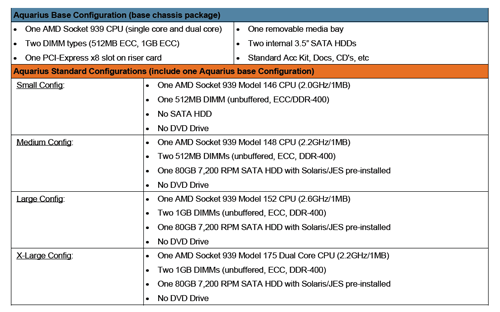


Also present is a half-height 1- to 8-lane PCIe expansion bay, two Gigabit Ethernet connectors and a single analog video output. The PCIe expansion is unique in the fact that the entire expansion bay is removable from the chassis when the bay cover is removed; no more scratched PCBs when replacing or installing an expansion card.
The V40z and V20z were innovative in their own rights, but much credit was due to Newisys, the company that designed and built many of the components in those servers. Today, however, the Aquarius (and Galaxy) servers are 100% Sun designed and manufactured. The server takes all of the better computing principles of Opteron, and combines them into a state of the art half depth 1U.
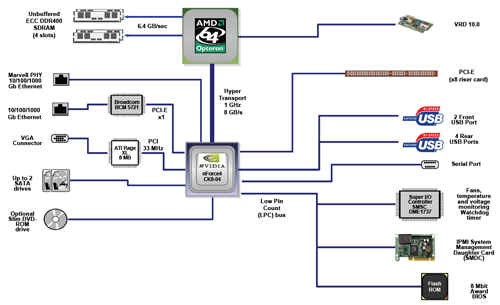
Aquarius is also unique in the fact that the server uses Socket 939 1xx Opterons. These new Socket 939 Opterons have only a single HyperTransport link as opposed to three, which keeps the cost of the chip down. The Socket 939 Opterons also features organic packaging, rather than the traditional ceramic packaging on Socket 940. A peripheral benefit of Socket 939 is that the CPU does not require expensive registered memory; off-the-shelf unbuffered ECC PC-3200 works just fine. The SunFire X2100 actually works just fine without ECC memory either, but with the cost of PC-3200 so cheap these days, why not? The Socket 939 Opterons are a little less picky with the memory configurations; mixing 1GB DIMMs with 512MB DIMMs is perfectly acceptable, but the DIMMs will have to be matched in order for the Opteron to enable dual channel mode.
NVIDIA's nForce4 controller forms the backbone of the Aquarius. There is only a single x8 PCIe lane, and a single HyperTransport lane from the MCP to the Socket. Only two of nForce4's SATA channels are utilized in the X2100, but from what we could tell in the BIOS, all RAID functionality still works. A single PCIe lane is dedicated to the Broadcom BCM 5721 controller giving the system two dedicated Gigabit Ethernet controllers (the other Gigabit Ethernet is located on the nForce4 chip).

Sun's attention to detail scored a lot of points in previous analyses, particularly with regard to system management. The SunFire's X2100 system processor - a QLogic Zircon - sits on a dedicated System Management Daughter Card (SMDC). Initial samples of the Aquarius did not have SMDC boards installed on them, but we lucked out and received one of the first samples in the US with the controller.

- Power Up, Power Down
- System Reset
- System Power Cycle
- System NMI
- Request Message Redirection
In true Sun fashion, the SunFire X2100 is hardly a quiet device. We measured the device in excess of 60dBA from twelve inches away during heavy operation, but since the majority of the X2100's life will be spent in a server room, that's not a problem. On the other hand, the Opteron 175 stayed under 50 degrees Celsius during normal operation according to our SMDC.
The Test
Using data from previous Linux and Solaris servers, we will attempt to analyze the performance of our X2100.
| Test Configurations | ||
| Machine: | SunFire X2100 "Aquarius" | |
| Processor: | (1) AMD Opteron 175 | |
| RAM: | 4 x 1024MB PC-3200 | |
| Hard Drives | 120GB Seagate Barracuda 7200.8 SATA | |
| Memory Timings: | Default | |
| Operating System(s): | SLES 9 SP2 RHEL 4 |
|
| Compiler: | linux:~ # gcc -v Reading specs from /usr/local/lib/gcc/i686-pc-linux-gnu/3.4.2/specs Configured with: ./configure Thread model: posix gcc version 3.4.2 |
|
Our SunFire X2100 came with Seagate's 80GB 7200.7 SATA drive. We have a specific hard drive image that we use for the majority of our Linux testing, so we opted to swap the stock hard drive for a 7200.8.
We only had the opportunity to test our configuration with SLES 9 SP2 and RHEL 4 during the X2100's stay at the AnandTech labs. The server is fully supported under Solaris 10, with advanced optimizations for dual core processors in the upcoming Solaris 10 u1 (Solaris 9 has no dual core optimizations). Windows Server 2003 32 and 64 are both optimized for the SunFire X2100 as well. Solaris 10 came pre-installed on our Aquarius, but in order to save time, we swapped the drives with our standard Linux benchmark drive instead.
The majority of the other systems in our analysis today are other Sun workstations and servers that we have looked at in the past.
Database & Apache Benchmarks
MySQL 4.0.20d
MySQL has been a staple of our Linux tests since its inception. Even though it does not carry high relevance for a workstation test, we still regard it as the de facto free, open sourced benchmark for Linux. Below, you can see our results for sql-bench on both the 64-bit Red Hat kernel. Below, we ran the sql-bench insertion and select tests.
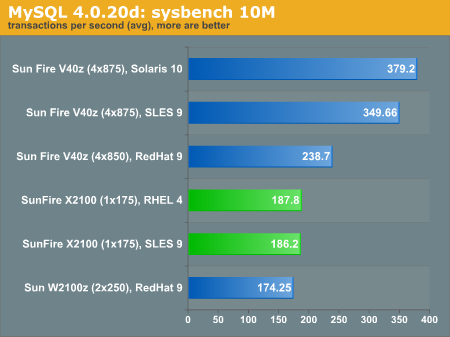
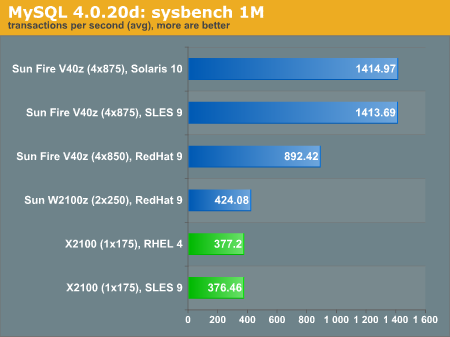
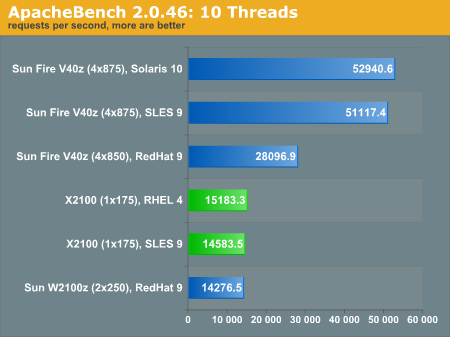
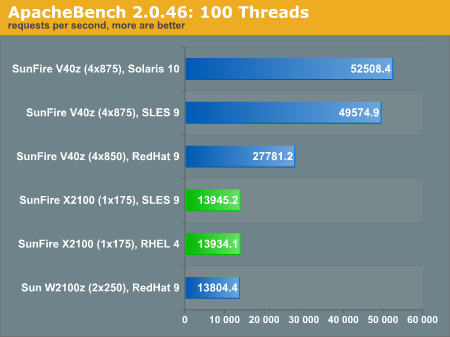
Rendering Benchmarks
Mental Ray 3.3.3
Below, we are running the 32-bit binaries provided by Alias Wavefront. You may be interested to see how some single CPU setups perform on the same test render here. Once again, we are running the same Maya benchmark file found in our other reviews. We ran Mental Ray via Maya using the command:
# maya_render_with_mr -file Benchmark_Mental.mb
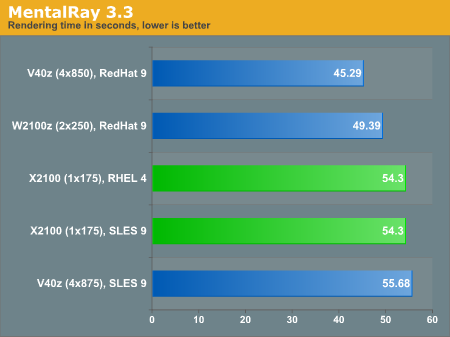
Shake 3.5c
We are planning on moving this benchmark to Shake 4.0, but since we had all of our existing benchmarks in 3.5c, we opted for 3.5c one last time. We took the opportunity to run a benchmark script by Lindsay Adams, which you can download here. The benchmark script renders 10 frames under various effects using one or multiple CPUs. We sum the render times and display them below. The times recorded are the averages of three runs. The command run for this benchmark is:
# shake -exec hardware_test_v01.shk -vv
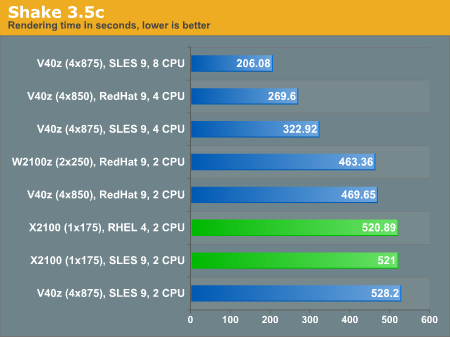
Compiling
We expect our X2100 to take the largest hit in performance here, during the compiling tests. Our previous analyses have shown that hard drives are often the bottleneck on heavy compiles. Our Aquarius uses SATA rather than SCSI, a performance hit for any server doing heavy compilations. Then again, the Aquarius also has a lighter core logic when compared to other systems that we've looked at in the past, as well as faster unbuffered memory.
GNU Make 3.79.1 / GCC 3.4.2
While GCC isn't multithreaded, we can run multiple jobs using the -j command in make. Below, you can see the significant improvement on performance going from 1 to 3 jobs. We used the commands as below to compile the Linux 2.6.4 kernel from kernel.org:
# yes "" | make config
# time make -jX
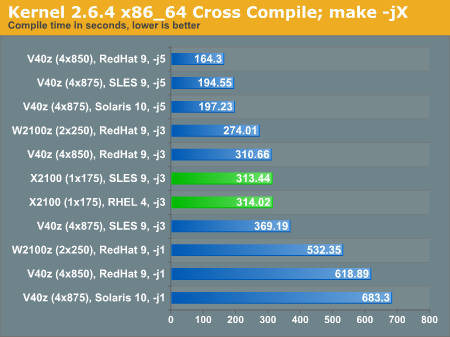
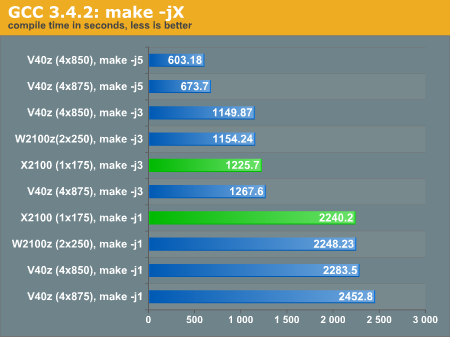
Final Thoughts
Today's look at the SunFire X2100 was one of the most exciting system launches that we've seen in a while. The SunFire X2100 takes all of the better elements of nForce4, Opteron and IPMI, and combines them into a very affordable, scalable node. Sun manages to cut the cost of many of the more expensive components in favor of efficient, cutting-edge tech instead. Particularly impressive is Sun's ability to sell these components at such a reasonable cost. Yes, as ironic as "Sun" and "reasonable cost" sound together in a sentence, the low end Aquarius servers are actually a very good value. Whiteboxing the components alone for Sun's "small" configuration of the X2100 would generally run in the neighborhood of $500, but other amenities like the roll-out rack rails, hot swap SATA drive bays, Solaris 10, and IPMI service processor quickly escalate the price further.
The performance of our "extra large" configuration was nearly on par with dual Opteron servers and workstations that we've looked at in the past, but at a fraction of the cost and footprint. Using Sun's N1 and other management tools actually make it much more cost effective to buy four Aquarius nodes (perhaps only one with a hard drive even) rather than a single quad Opteron server (if your particular application scales, that is).
Another interesting position of Sun's new direction includes the prospect that end users will probably reconfigure the hardware (particularly the entry level components), as soon as they get them. Even though Sun is happy to provide clients with bleeding edge hardware off the factory floor, during my conferences with Sun, there seemed to be an expectation that end users buying a few of these new SunFires will add a few more sticks of memory, or a PCIe InifiniBand adaptor - particularly on the entry level x64 servers like the one that we saw today. Sun doesn't seem too upset about this either; the company's new direction seems very clearly laid out toward selling efficient and innovative technology as a bottom line rather than gouging repeat customers on proprietary hardware.
Now that Mr. Bechtolsheim's influence has started to propagate through all levels of Sun again, the new products and services of the company are clearly redefining themselves with his direction. Sun is clearly using their size to reclaim a lot of territory that they lost after the dot-bomb, and products like the SunFire X2100 will continue to get them back to that point.







